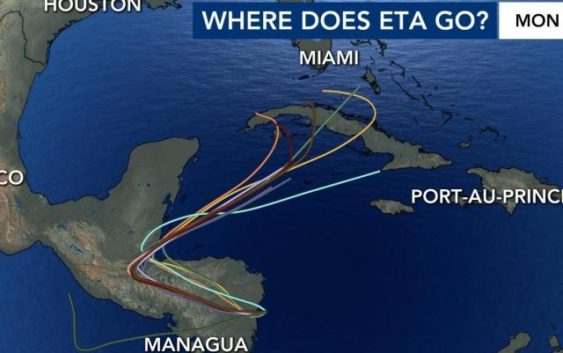- Western NC neighborhood still reeling from Hurricane Helene flood damage
- Ashe County Schools reopen after Hurricane Helene hit area over a month ago
- Ashe County Schools reopen Tuesday after Hurricane Helene hit area
- Carolina Hurricanes foundation donates $50,000 to rebuild Asheville hockey rink
- Stress, shelter, and safety: Hurricane Helene's effect on domestic violence victims in NC
Hurricane Eta lashes Nicaragua, knocking out power and causing flooding

Hurricane Eta lashed Nicaragua’s Caribbean coast Tuesday morning, unleashing heavy rainfall and intense winds, knocking out power, causing flooding and tearing corrugated metal roofs off homes in one of the country’s poorest regions, Nicaraguan officials said.
Despite the storm’s ferocity, however, Guillermo González, director of the country’s emergency management agency, said in a news conference that there had been no reports of injuries or deaths, The Associated Press reported.
But even as the Category 4 hurricane pounded the Nicaraguan coast, there appeared to be disagreement between Nicaraguan and U.S. authorities about where the storm was.
Nicaragua’s disaster management agency reported on Twitter that the eye of Eta had made landfall at 5:30 a.m. Eastern time, south of the port town of Puerto Cabezas.
But the National Hurricane Center in Miami said in a 10 a.m. advisory that the hurricane was still some 30 miles south-southeast of Puerto Cabezas, moving west-southwest at 5 mph, and was expected to make landfall later Tuesday.
“Life-threatening storm surge, catastrophic winds, flash flooding and landslides expected across portions of Central America,” the Hurricane Center advisory said.
A hurricane warning was in effect for a stretch of the Nicaraguan coast from the border with Honduras in the north to Sandy Bay Sirpi.
The storm was expected to move over northern Nicaragua through Wednesday morning and then across central portions of Honduras by Thursday morning, losing strength as it leaves the Caribbean behind, the Hurricane Center said.
In addition to catastrophic wind damage, forecasters said the hurricane could dump as much as 25 inches of rain on much of Nicaragua and Honduras, with volumes reaching 35 inches in some locations. Eastern Guatemala and Belize were expected to receive 10-20 inches, while portions of Panama and Costa Rica could see 10-15 inches.
Forecasters also warned of a storm surge of as much as 21 feet above normal tide levels along the Nicaragua coast, and swells causing “life-threatening surf and rip current conditions” along the Caribbean coast in Central America and the Yucatán Peninsula of Mexico.
Nicaragua has begun evacuations and emergency aid.
Nicaraguan authorities rushed Monday to evacuate inhabitants from low-lying areas along the Caribbean coast and ship in emergency supplies as Hurricane Eta neared landfall.
The Nicaraguan government sent 88 tons of food to the port town of Puerto Cabezas ahead of the storm, according Nicaragua’s national disaster response agency.
Officials also dispatched four trailers loaded with supplies including mattresses and hygiene kits, the agency said, and sent food supplies including rice, oil and protein supplements.
“In this way, the government of Nicaragua will be able to provide quick and effective humanitarian aid to families,” said Dr. Guillermo González, the director of the agency, the National System for Disaster Prevention, Mitigation and Attention.
Officials said that more than 3,000 families had been evacuated from coastal areas, according to local press reports. In Honduras, evacuations were also underway Monday, and severe weather conditions had forced the closure of some ports, Reuters reported.
Forecasts include ‘jaw-dropping’ levels of rain.
Eta is bringing powerful winds and a huge storm surge as it makes landfall, threatening coastal areas in Honduras and Nicaragua. But the hurricane is also expected to cause damage farther inland, as it churns across southeast Mexico and parts of a half dozen or more countries in Central America and the Caribbean by Friday.
The strength and expected path of Eta recalls Hurricane Mitch, from 1998, which killed more than 11,000 people, mostly in Honduras and Nicaragua. Heavy rains exacerbated by Mitch’s slow march across the region triggered devastating flooding and mudslides.
“While it is interesting #Eta has tied the 2005 named storm record, much more serious is the extreme rain event in Nicaragua and Honduras,” Eric Blake, a senior hurricane specialist at the National Hurricane Center, wrote on Twitter on Sunday. “A forecast of 30 inches of rain is jaw-dropping, and we could be looking at one of the worst flooding disasters there since Mitch.”
The National Hurricane Center has raised the forecast for Eta to 35 inches of rain in parts of Nicaragua and Honduras. The National Hurricane Center also warned of flash flooding and river flooding across Jamaica, southeast Mexico, El Salvador, southern Haiti as well as the Cayman Islands.